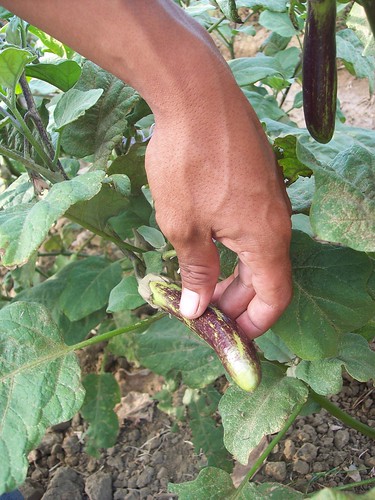Searching for a Wild Ancestor
Posted in Exhibitions, Science, The Edible Garden on September 2 2009, by Plant Talk
NYBG Student Travels to Asia to Trace Eggplant’s Roots
 |
Rachel Meyer, a doctoral candidate at the Botanical Garden, specializes in the study of the eggplant’s domestication history and the diversity of culinary and health-beneficial qualities among heirloom eggplant varieties. She will hold informal conversations about her work at The Edible Garden‘s Café Scientifique on September 13. |
 The eggplant (Solanum spp.) may not seem like the world’s most exciting food crop at first thought, but its history and diversity are actually quite intriguing. The common name, “eggplant,” actually covers more than one species, whose size, shape, color, and flavor are remarkably different throughout the world.
The eggplant (Solanum spp.) may not seem like the world’s most exciting food crop at first thought, but its history and diversity are actually quite intriguing. The common name, “eggplant,” actually covers more than one species, whose size, shape, color, and flavor are remarkably different throughout the world.
People have grown eggplants for over 2,000 years in Asia, and it is thought that eggplants were used as medicine before being selected over time to become a food. Many present-day cultivars of eggplants still contain medicinally potent chemical compounds, including antioxidant, aromatic, and antihypertensive, some of which might be the same compounds responsible for flavor as well.
If we can unravel the history of the eggplant’s domestication and investigate the health-beneficial and gastronomic qualities of heirloom eggplant varieties, we can promote specific varieties that may be useful to small-scale farmers, practitioners of alternative medicine, and eggplant lovers around the world.
I spent seven weeks in China and the Philippines last winter exploring how different ethnic groups use local eggplant varieties. These regions in Asia are important, because scientists are still not sure where eggplants were first domesticated (that is, selected by people over generations for desirable qualities instead of just harvested from the wild). We know it was in tropical Asia, but the written record doesn’t go back far enough to provide more clues. For that reason I also collected wild relatives of eggplant that might be the ancestor of the domesticated crop.
I traveled to the most tropical part of China, Xishuangbanna, where I found eggplants growing everywhere—from cracks in the walls to gardens where they were as large as trees! The diversity of the cultivars was amazing. Two criteria for identifying a center of crop domestication are that 1) the plants are totally adapted to the local climate, and 2) varietal diversity is high. Xishuangbanna meets both these criteria and might have eggplant varieties of great historical importance.
Additionally, the ethnobotanical knowledge of the local people regarding eggplant is very deep, and they have dozens of medicinal uses for eggplant, many of which can be traced back hundreds of years. I am still searching for ancient literature from this region to learn more about the early domestication history of eggplant there. Some of the most ancient Chinese texts that discuss eggplant were written by Silk Road traders and doctors who treated Chinese emperors. My friend and colleague Zhao Yu Fan from Sichuan is helping me search out and translate these fascinating documents for early references to eggplant.
I am very interested in investigating the relationship between plants and people and how people were able to breed out toxins and breed in healthy compounds that may or may not have a detectable flavor. It’s important to identify the wild ancestor of the eggplant to establish the starting point.
To do this, I am using population genetic tools, which also help in studying the relationships among eggplant cultivars—I currently have over 100. I use the fruits of these cultivars to explore the desirable chemical compounds that contribute to flavor and health benefits. All of this information will potentially lead us to understand how the chemistry of eggplant has changed during the course of its geographic and evolutionary history.
I am then going one step further—to study the genes that are responsible for making those desirable compounds so I can see if their activity was altered as a result of selection. So not only will we learn more about eggplant’s history and the history of crop trade in Asia, but we will understand more about how the chemical compounds themselves are made, which might be useful in the field of modern medicine.
This is what I am most excited about: fusing all of the data together to try to decode some of the mysteries history leaves us with, and along the way to find out things about food, medicine, and agriculture that could be applied to our society and potentially help people.

